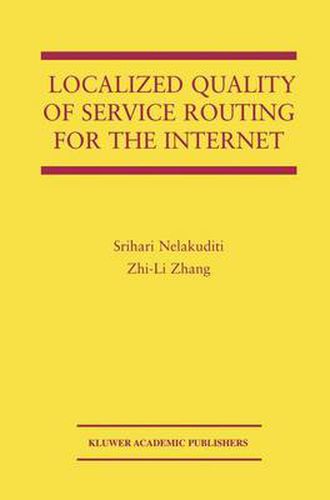Readings Newsletter
Become a Readings Member to make your shopping experience even easier.
Sign in or sign up for free!
You’re not far away from qualifying for FREE standard shipping within Australia
You’ve qualified for FREE standard shipping within Australia
The cart is loading…






This title is printed to order. This book may have been self-published. If so, we cannot guarantee the quality of the content. In the main most books will have gone through the editing process however some may not. We therefore suggest that you be aware of this before ordering this book. If in doubt check either the author or publisher’s details as we are unable to accept any returns unless they are faulty. Please contact us if you have any questions.
Under Quality of Service (QoS) routing, paths for flows are selected based upon the knowledge of resource availability at network nodes and the QoS requirements of flows. QoS routing schemes differ in the way they gather information about the network state and select paths based on this information. This text broadly categorizes these schemes in to best-path routing and proportional routing. The best-path routing schemes gather global network state information and always select the best path for an incoming flow based on this global view. On the other hand, proportional routing schemes proportion incoming flows among a set of candidate paths. We have shown that it is possible to compute near-optimal proportions using only locally collected information. Furthermore, a few good candidate paths can be selected using infrequently exchanged global information and thus with minimal communication overhead. This text describes these schemes in detail demonstrating that proportional routing schemes can achieve higher throughput with lower overhead than best-path routing schemes. It first addresses the issue of finding near-optimal proportions for a given set of candidate paths based on locally collected flow statistics. This book will also look into the selection of a few good candidate paths based on infrequently exchanged global information. The final phase of this book will describe extensions to proportional routing approach to provide hierarchical routing across multiple areas in a large network.
$9.00 standard shipping within Australia
FREE standard shipping within Australia for orders over $100.00
Express & International shipping calculated at checkout
This title is printed to order. This book may have been self-published. If so, we cannot guarantee the quality of the content. In the main most books will have gone through the editing process however some may not. We therefore suggest that you be aware of this before ordering this book. If in doubt check either the author or publisher’s details as we are unable to accept any returns unless they are faulty. Please contact us if you have any questions.
Under Quality of Service (QoS) routing, paths for flows are selected based upon the knowledge of resource availability at network nodes and the QoS requirements of flows. QoS routing schemes differ in the way they gather information about the network state and select paths based on this information. This text broadly categorizes these schemes in to best-path routing and proportional routing. The best-path routing schemes gather global network state information and always select the best path for an incoming flow based on this global view. On the other hand, proportional routing schemes proportion incoming flows among a set of candidate paths. We have shown that it is possible to compute near-optimal proportions using only locally collected information. Furthermore, a few good candidate paths can be selected using infrequently exchanged global information and thus with minimal communication overhead. This text describes these schemes in detail demonstrating that proportional routing schemes can achieve higher throughput with lower overhead than best-path routing schemes. It first addresses the issue of finding near-optimal proportions for a given set of candidate paths based on locally collected flow statistics. This book will also look into the selection of a few good candidate paths based on infrequently exchanged global information. The final phase of this book will describe extensions to proportional routing approach to provide hierarchical routing across multiple areas in a large network.